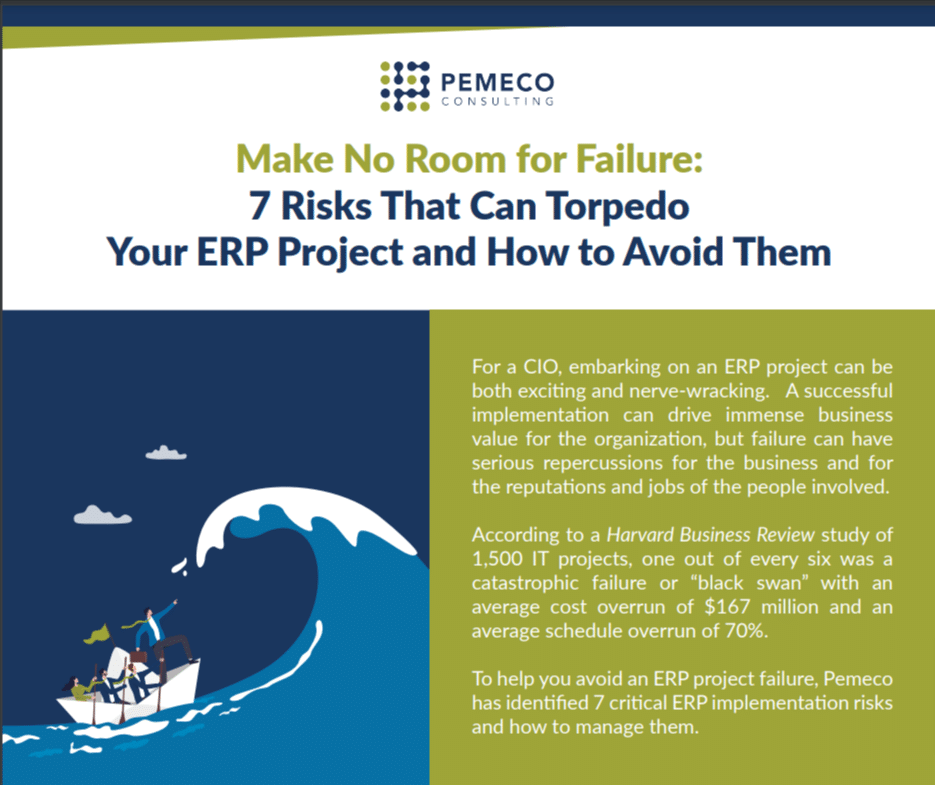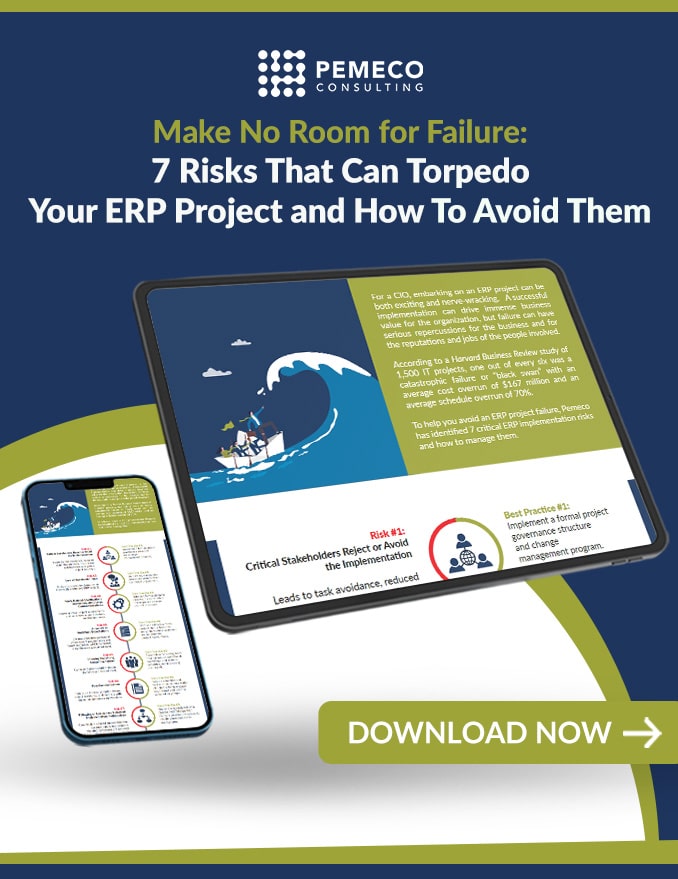You want to streamline your business process and simplify your job—and let’s be honest, who doesn’t? That’s why enterprise resource planning (ERP) exists.
However, most ERP implementation efforts fall short. Companies invest significant time and money in digital transformation projects, but most of that ends up wasted due to high failure rates.
Recent data from Mint Jutras shows that only 12% of companies would say their ERP implementation was very successful. Likewise, a 2021 McKinsey report states that the digital transformation success rate has remained stagnant at 30% for 15 years. Plus, the greatest value loss (35%) occurs during implementation.
So what’s going wrong? Misguided priorities.
Where Do Companies Fall Short?
ERP implementation is a massive undertaking. Understandably, companies focus on redesigning and testing new business processes. But that often results in tunnel vision.
While companies understand—in theory—the importance of stakeholder adoption, they often don’t prioritize it when implementing digital transformation. And if the end-users can’t properly use the new systems, the success rate drops.
In other words, the high ERP implementation failure rate results from underinvesting in stakeholder communication and training.
Communication
Effective communication directly correlates to success. The aforementioned McKinsey report found that nearly 80% of companies with a successful digital transformation clearly communicated the need for change and their objectives. However, keep in mind that these companies only form less than one-third of organizations.
The rest fall short when communicating with both internal and external stakeholders.
Many companies fail to properly explain the scope of transformation deliverables. This leaves employees guessing how their daily responsibilities will change and how the new processes will work.
Another internal communication issue is the failure to set realistic performance expectations and prepare employees for the inevitable ERP emotional curve. It’s completely normal for businesses to struggle after go-live. Employees are still adjusting to the changes, and the IT team needs time to iron out any issues that surface.
But not preparing them for those difficulties and setting realistic goals before—and during—implementation can result in employee stress and, potentially, a wave of resignations.
Similar communication pitfalls occur with external stakeholders, like customers, regulators, and vendors. Failure to announce the upcoming changes, provide adequate training, and give external users time to adopt the new processes can lead to business complications and even revenue loss.
In short, a lack of proactive communication throughout the digital transformation process hinders both internal and external alignment.
Training
Effective communication must come with proper training. Talking about the upcoming changes is one thing, but actually teaching your stakeholders how to adopt the new processes is another. And waiting until after cutover to introduce these new processes is much too late.
Training needs to occur well before go-live so that employees have time to adjust to the changes. Too often, companies expect everyone to immediately start hitting performance goals on day one without any hands-on training. Just like with the lack of communication, these unrealistic expectations contribute to user frustration and, ultimately, ERP implementation failure.
Plus, the companies that do incorporate training initiatives often lump everyone into one group. Simultaneously training everyone is not feasible in the long run, and it can result in disorganized processes and jumbled feedback.
Or maybe some companies do train a core team first that will later train the end-users. This situation is ideal, but the training is often insufficient. The core team is often unequipped to fulfill essential duties like mapping business processes and testing the ERP system. And then, when they try to train the end-users, they are grasping at straws due to their own limited training. This creates a chain reaction of poor training, leading to ERP implementation failure.
Four Strategies for Success
Successful digital transformation requires effective organizational change management. This structured approach to transitioning your company through ERP implementation—or any major change—supports the employees and helps them adapt to the new environment. An effective change management plan allocates procedures that you can plan, track, act upon, and measure.
Here are four strategies to include in your change management plan and help streamline your ERP system implementation.
Fill Critical Roles
Digital transformation does not happen overnight. You need team members who dedicate their full time to these processes.
When building project teams, it’s important to fill critical training and communication positions alongside other key roles such as project managers, solutions architects, functional leads (such as sales and manufacturing), and business systems analysts.
Ideally, these “core team members” are fully dedicated to the project and backfilled in their day-to-day jobs. However, this isn’t practical (or financially feasible) for small and midsized businesses. Nonetheless, small businesses with limited resources should still ensure that core team members dedicate at least 50% of their time to the ERP implementation or other digital transformation project to ensure its overall success.
Build a Training Plan
Two key audiences require unique training approaches: your core team and end-users. You must first train the core team well before go-live, so they have months—or even years—to implement the ERP system. Your training plan should consist of four key pieces:
- An overview session: Train your core team on general theories relating to the ERP system.
- Navigation training: This is a hands-on approach to software training where your core team will learn how to navigate the system.
- Functional training: Your team learns the software tools that relate to their respective functional departments.
- Systems administration training for IT core team members: This training covers concepts related to software administration such as the application of patches and upgrades.
After the core team members have completed this four-step training process, they become your enterprise system experts focused on key implementation activities such as process mapping, system design and configuration, testing and piloting, and end-user training.
Once they near the end of the implementation process, the core team members will then train your end users. End-user training is an exercise in both skills development and self-sufficiency. It should include comprehensive work instructions, training guides, and a detailed plan to help accelerate user adoption.
Ensure Effective Communication
Of course, training—and digital transformation projects—can’t occur without proper communication.
Set your company up for success by establishing effective communication from the start. And then carry that communication through the entire implementation process and beyond.
Make sure you:
- Communicate the need for digital transformation.
- Share company-wide and departmental goals with the ERP implementation.
- Advise project teams on any status updates and support issue resolution.
- Prepare internal stakeholders for the change.
- Discuss the inevitable brief dip in business performance post-go-live.
- Set realistic expectations.
- Explain the potential changes to external stakeholder groups.
- Review how those changes might impact them. For example, suppliers might receive a different purchase order form.
Companies should use various communication methods when relaying this information. One-way communication channels such as press releases, intranet postings, and email newsletters work well for announcements or system updates.
Two-way communication is just as vital. Hosting departmental meetings or town halls help foster conversations about the implementation process. You can gather invaluable user feedback and learn about issues that would otherwise go unnoticed. Project leaders can then take this information and improve the process, pushing your company closer to a successful ERP implementation.
Have a Post-Implementation Stabilization and Optimization Plan
Your efforts don’t end at go-live. After a lengthy implementation stage, you need a post-implementation user adoption plan.
Complete a post-go-live adoption audit a few months after go-live to see how well everyone adjusted. If you find any issues, revisit the training. Make sure all training materials are accessible and up-to-date. You can also use this time to gather feedback and make any changes to the system or processes to improve the end-user experience.
Proper Training + Communication = Successful Implementation
Organizational change management helps ensure success in ERP or digital transformation projects—if it’s done effectively.
Effective training and communication are the two pillars of successful organizational change management. And when you fill critical roles with the right people, they can help oversee communication and training. When you have these three core components, you have everything you need for successful ERP implementation and digital transformation.






